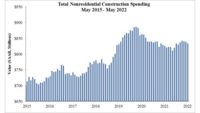While both July and August witnessed a loss of momentum from strong showings in previous months, the level of construction activity continues to be higher than a typical month during 1998, which itself was a very strong year for the building industry.
"The August data shows that construction contracting remains essentially healthy," stated Robert A. Murray, vice president of economic affairs for Dodge. "Housing is down a notch from the torrid pace experienced earlier in the year, but the level of homebuilding is still robust by the standards of the past two decades. With renewed support now coming from nonresidential building, total construction growth for all of 1999 should come close to matching the 8% average rate of increase for the 1992-98 period."
In particular, nonresidential building bucked the overall trend and grew 2%, to $148.8 billion. While stores and shopping centers fell 3%, most of the commercial project types showed stronger contracting, including offices (up 10%), warehouses (up 16%), and hotels (up 20%).
"Even with the heightened levels of office construction over the past three years," Murray observed, "vacancy rates in downtown markets remain on average below 10%, which sets the stage for further growth in office rents and more construction."
After a weak July, manufacturing plants bounced back 47% in August, helped by a $64 million expansion of an automotive assembly plant in Arlington, TX.
The institutional categories revealed a more mixed pattern. Several categories posted double-digit gains, including healthcare facilities (13%), amusement-related projects (18%), and church construction (27%). However, school construction retreated 7% from a strong July showing, while more substantial declines were reported for public buildings (courthouses and detention facilities, down 30%) and transportation terminals (off 53%).
Geographically speaking, the Northeast has enjoyed the best year so far, up 13%, while the West, still up 4% over 1998, is experiencing the least growth.





